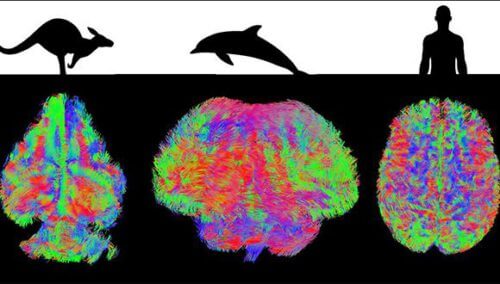A brain scan of about 130 species of mammals proved that the ability of the brain to transfer information from place to place is the same in all mammals
Researchers from various fields from Tel Aviv University conducted an advanced MRI scan of the brains of approximately 130 species of mammals, with the aim of identifying the level of connectivity within the brain

The million dollar question that still preoccupies the world of research is how the brain works. To this day, it is widely believed that the activity of our brains, humans, is more advanced than that of animals, but in a first study of its kind conducted at Tel Aviv University, a surprising result was obtained: contrary to popular belief, it turned out that evolution shaped the brains of all mammals in a similar way: the level of connectivity, i.e. The efficiency of transferring information from one place to another in the nervous system is the same in all mammals, including humans. Another finding discovered is a 'compensation mechanism', where the brain compensates for high connectivity in a certain area with relatively low connectivity in another area, to maintain a balance in the overall summary.
A winning evolutionary design
In a study conducted under the leadership of Prof. Yaniv Assaf from the School of Neurobiology, Biochemistry and Biophysics and Purple School of Neuroscience, and Prof. Yossi Yuval from the School of Zoology, Steinhardt Museum of Nature and Purple School of Neuroscience, conducted an advanced MRI scan of the brains of about 130 species of mammals, with the aim of identifying the level of connectivity within the brain.
"Brain connectivity, that is, the efficiency of transferring information from one place to another in the brain, is a central feature, of great importance to the functioning of the brain. Many researchers hypothesize that the level of connectivity in the human brain is significantly higher than that of other animals, as a possible explanation for the high functioning of the 'human animal,'" says Prof. Assaf. On the other hand, Prof. Yuval explains that "it is known that especially important features and functions are preserved during evolution. For example, all mammals have four limbs. In the study, we wanted to test the hypothesis that brain connectivity is an essential feature of this type, which does not change from mammal to mammal, regardless of its size and brain structure. For this, we used advanced research tools."
"We discovered that the connectivity in the brain does not depend on the size or structure of the brain. In other words, the brains of all mammals, from humans to mice, from cows to dolphins, maintain the same level of connectivity, and information arrives from place to place in the brain with the same efficiency," explains Prof. Assaf. "In addition, we found that in order to maintain the balance, the brain maintains a compensation mechanism: when the connectivity within the two halves of the brain (the hemispheres) is high, the connectivity between the hemispheres is low, and vice versa."
Researchers from the Beit Dagan University Veterinary Hospital participated in the study. from the Blavatnik School of Computer Science and the Faculty of Medicine at the Technion. The article was published in the prestigious journal Nature Neuroscience in June 2020.

Intelligent mammals
size does not matter
In the first phase, the researchers conducted MRI scans with advanced technology of the brains of mammals from about 130 different species (all brains were taken from dead animals, and not a single animal was killed for the purpose of the study), starting with tiny bats weighing 10 grams and ending with dolphins weighing hundreds of kilograms. The brains of about 100 of these mammals have never been scanned, so the research created an innovative and unique database of its kind in the world.
In addition, the brains of 32 living people were scanned with the same means. The unique technology, which identifies the white matter in the brain, made it possible to reconstruct the brain network: the nerve cell extensions in the brain that are used to transmit information, and the nodes where the extensions meet and transfer the information between them.
The next challenge was to compare the scans of animals of different species, whose brains are very different from each other in size and/or structure. To this end, the researchers recruited network theory, a field of mathematics that allowed them to measure and apply to all brains a uniform measure of connectivity, that is, the number of nerve cell nodes that certain information needs to travel from one place to another in the brain.
"The brain of a mammal consists of two hemispheres connected to each other through a system of fibers (nerve cell extensions) that transmit information," explains Prof. Assaf. "We tested for each brain we scanned four connectivity indicators: the level of connectivity within each of the hemispheres, left and right; the level of connectivity between the two hemispheres; and the level of connectivity of the entire brain. We found that the overall index for brain connectivity is very similar in all mammals, including humans. In other words: the information comes from place to place in the brain through the same number of nerve nodes in the brains of all mammals, whether it is a huge or tiny brain. However, it is important to note that different brains employ different strategies to maintain the same overall connectivity. In some brains we found strong connectivity within the hemispheres and weaker connectivity between them, and in some the opposite is true."
"In addition, we discovered that the differences in compensation in the level of connectivity between different parts of the brain characterize not only different species, but also different individuals of the same species", reveals Prof. Yuval. "In other words, even among rats, bats or humans there are individuals with more connectivity within the hemisphere and less between the hemispheres, and vice versa. It is very interesting to speculate how different types of connectivity affect different cognitive functions and human abilities such as sports, music or mathematics. In future research we intend to focus on these questions."
A new universal law
"In our research we uncovered a universal law: the law of preserving connectivity in the brain. The meaning of the law is that the level of efficiency of transmitting information in the nervous system of the brain is the same in all mammals, including humans, regardless of the size and structure of the brain," concludes Prof. Assaf. "Also, we discovered a brain compensation mechanism, which balances the level of connectivity in the individual brain. This mechanism means that high connectivity in a certain area, which is reflected in a special talent in a certain area (such as sports or music), is always balanced by a relatively low connectivity in another area of the brain. In the following studies, we will examine specific features and learning processes, and how the brain compensates for the thickening of connections in a certain area."
More of the topic in Hayadan:

5 תגובות
If you want to show proof of evolution, please: https://youtu.be/plVk4NVIUh8
This is an evolution of several hours/days. We are human beings, a poor and wretched creature, with a history of how much? 7000 years? According to Jewish counting, God created the world plus or minus 5000 years ago?
How on earth can you, I, or anyone else, make sense of 3,000,000,000 years of evolution on Earth, let alone 15,000,000,000 years since the big bang, please explain to me. And we know very well that this is the age of the visible universe, it is 1+1 of optics with the speed of light. If we're wrong, that just means the universe is even older.
MRI of the brains of dead animals…
Hmmm…. How idiots do you think we are...
Man is allowed from the animal. The ability to distinguish between good and bad. Removed. Free Love. There is one man here who has lost all these advantages - the Prime Minister
It's strange how intelligent people believe in the nonsense of evolution.. Let's say a fish turned into a monkey. Let's say... But what about the laws of physics?.. Chemistry?.. Biology?.. Who set the laws?.. A matter-of-fact and smart response to this video from the learned website. you are welcome.
https://www.youtube.com/watch?v=duiM-j9EDOw
Man is allowed as an animal species - I don't care why he only tested mammals, did the mechanism develop and be optimal up to mammals or is it the same also in ancient evolutionary chains such as reptiles, birds and fish